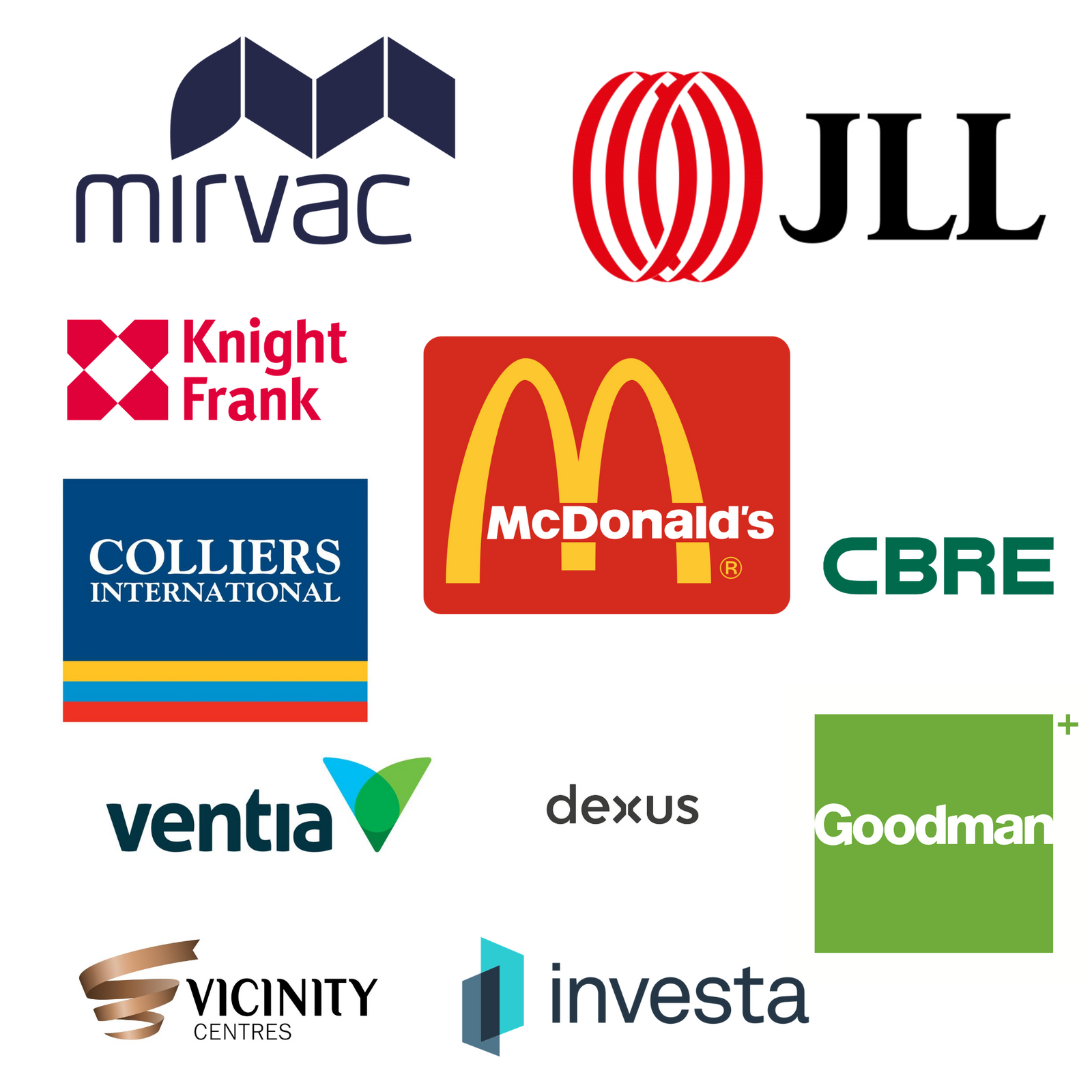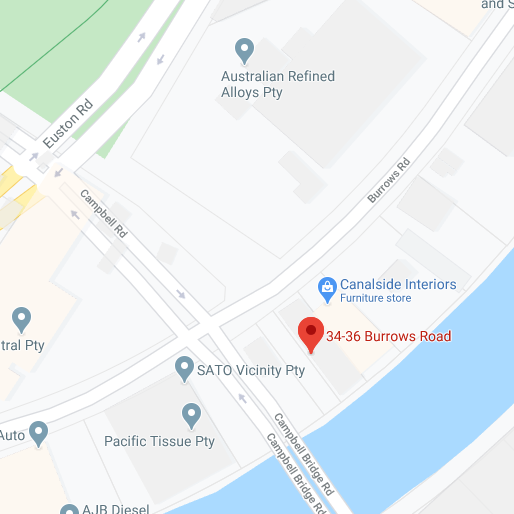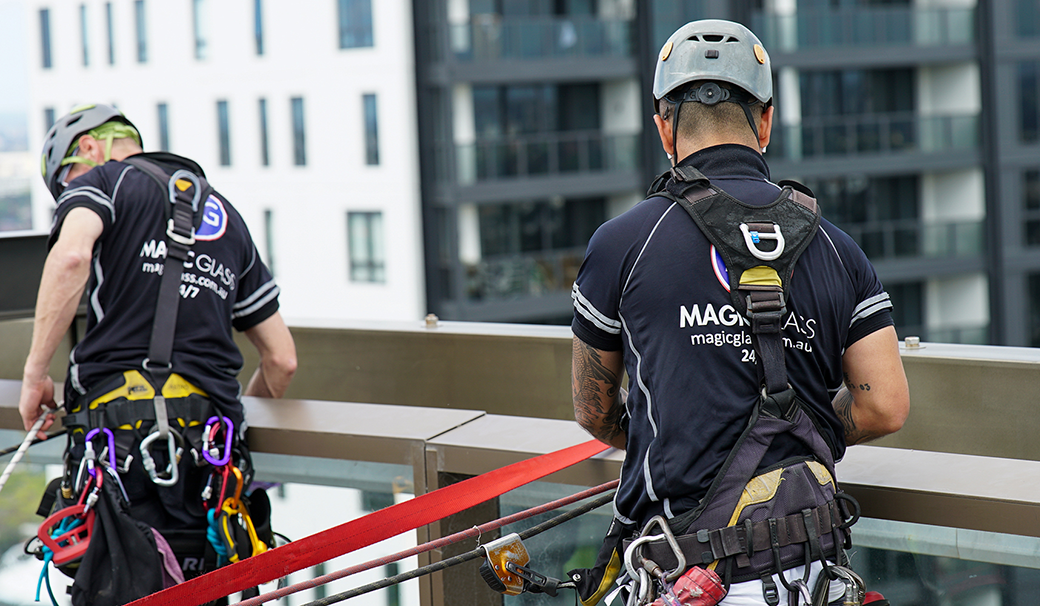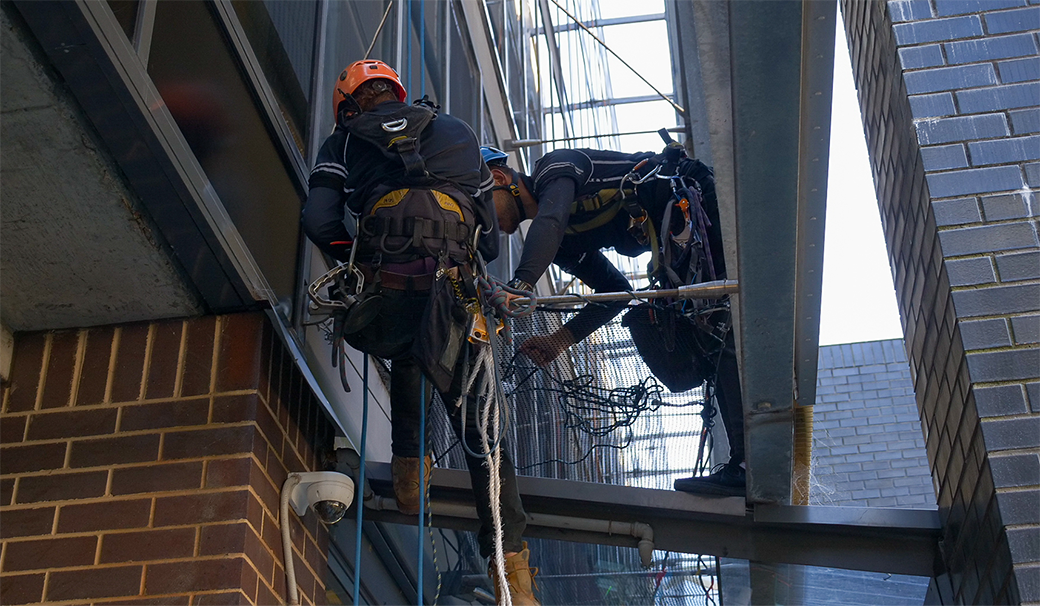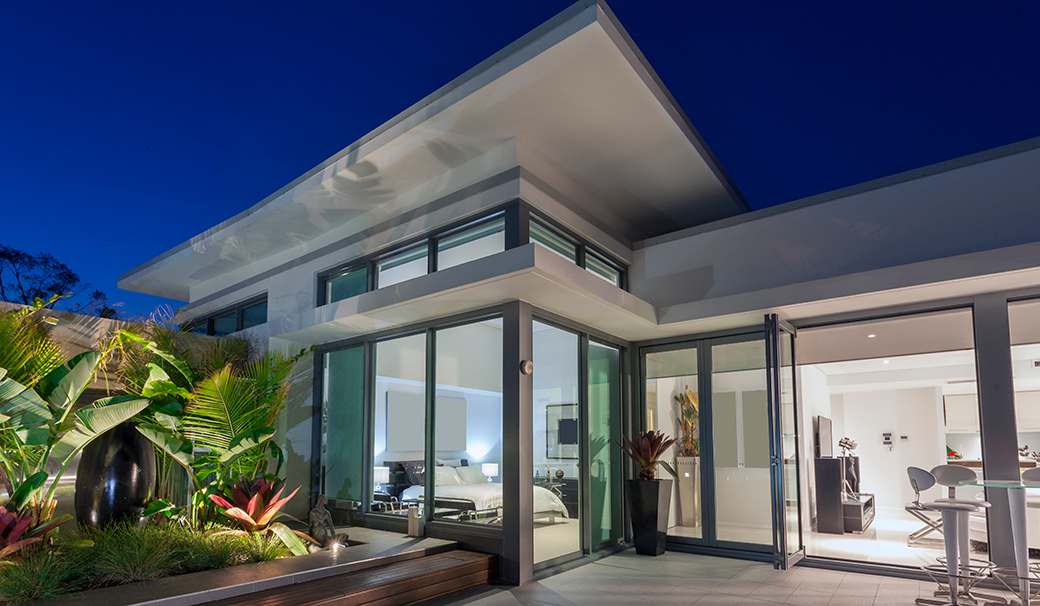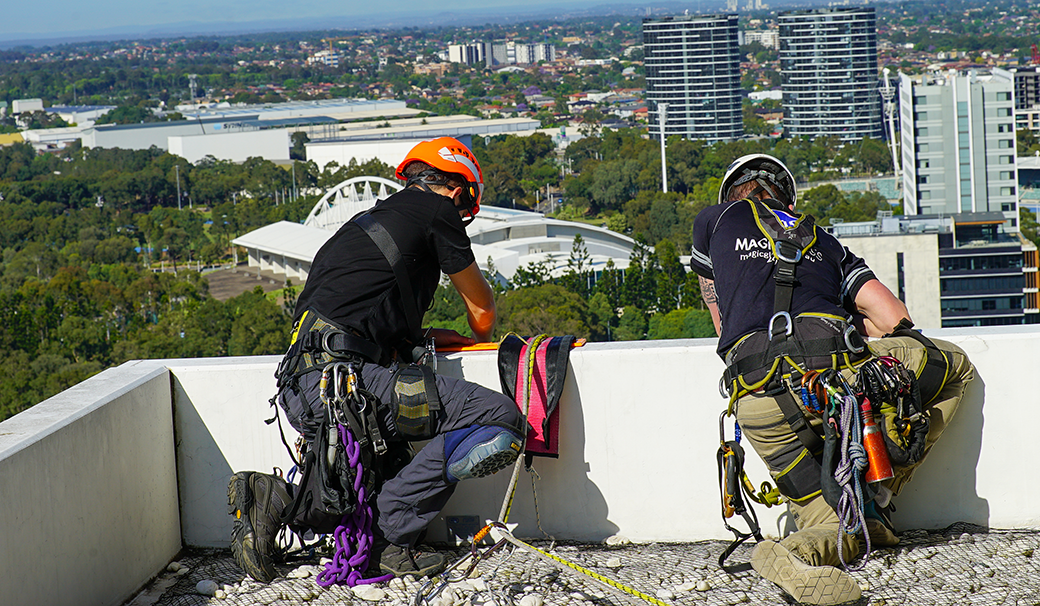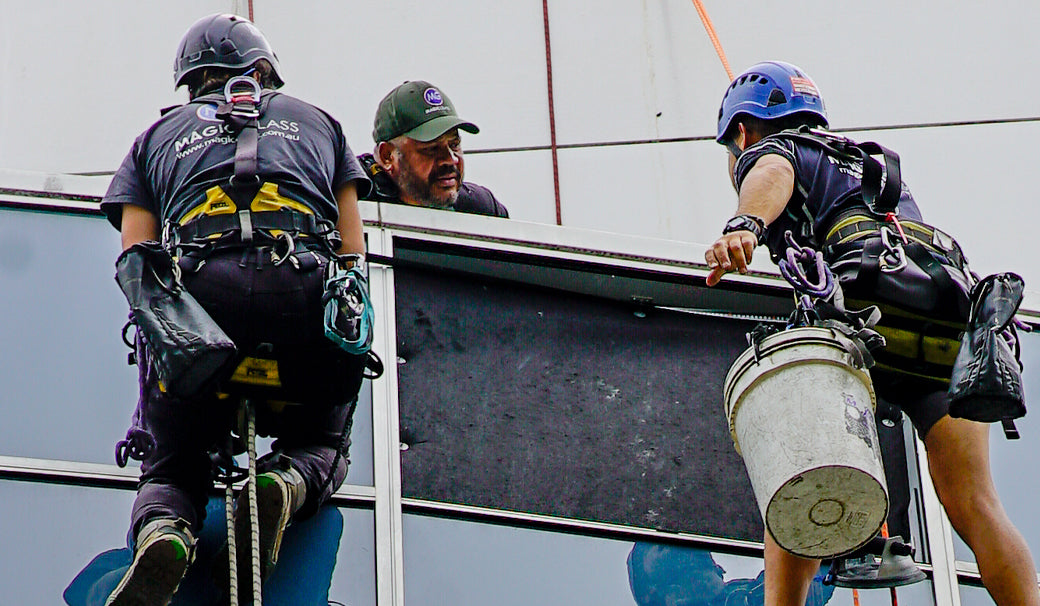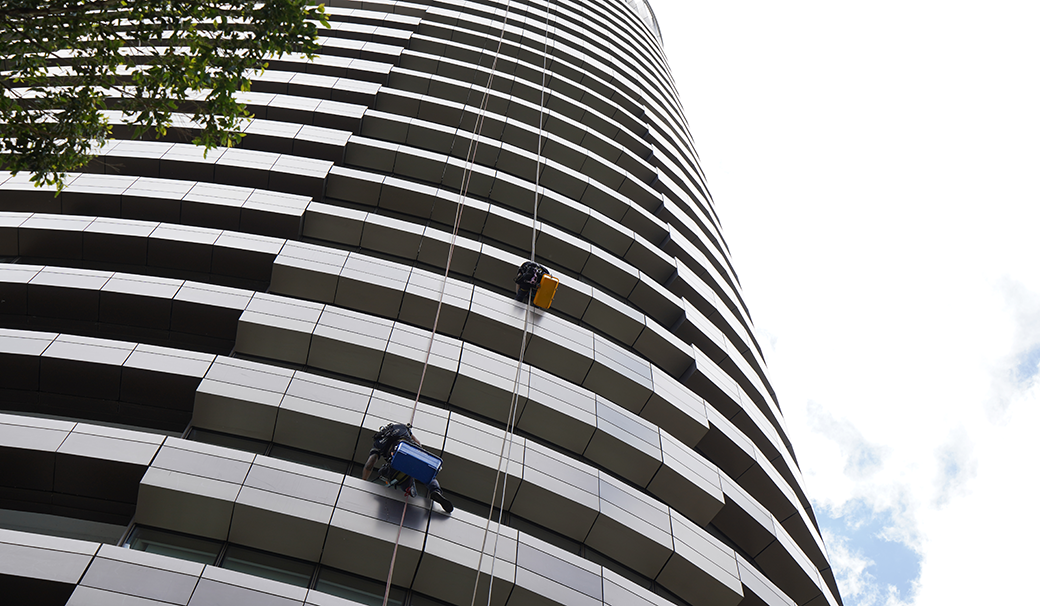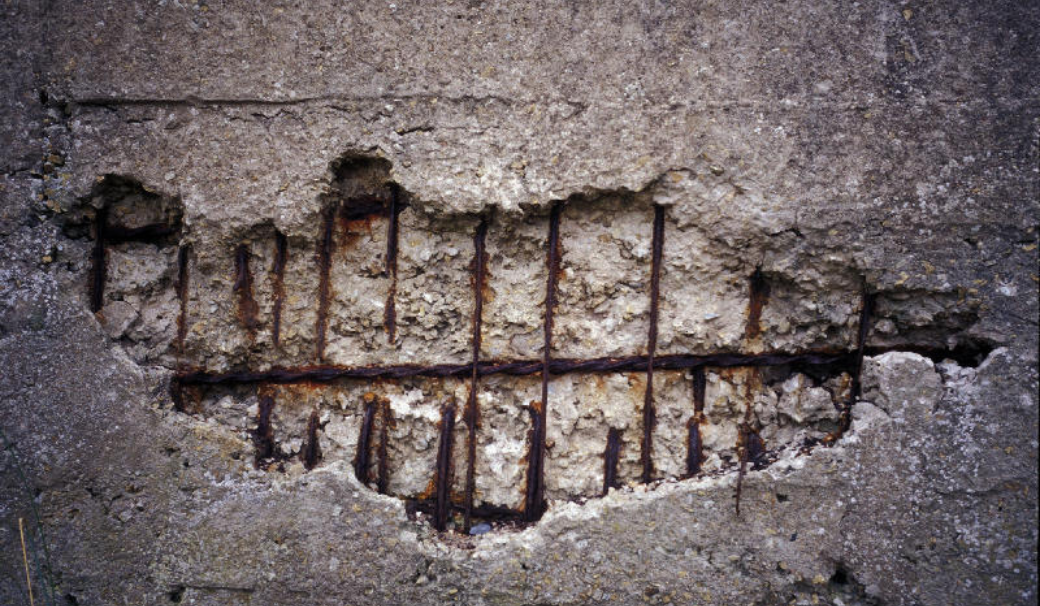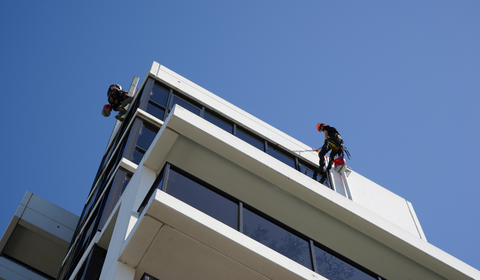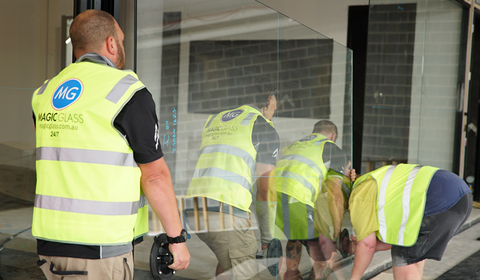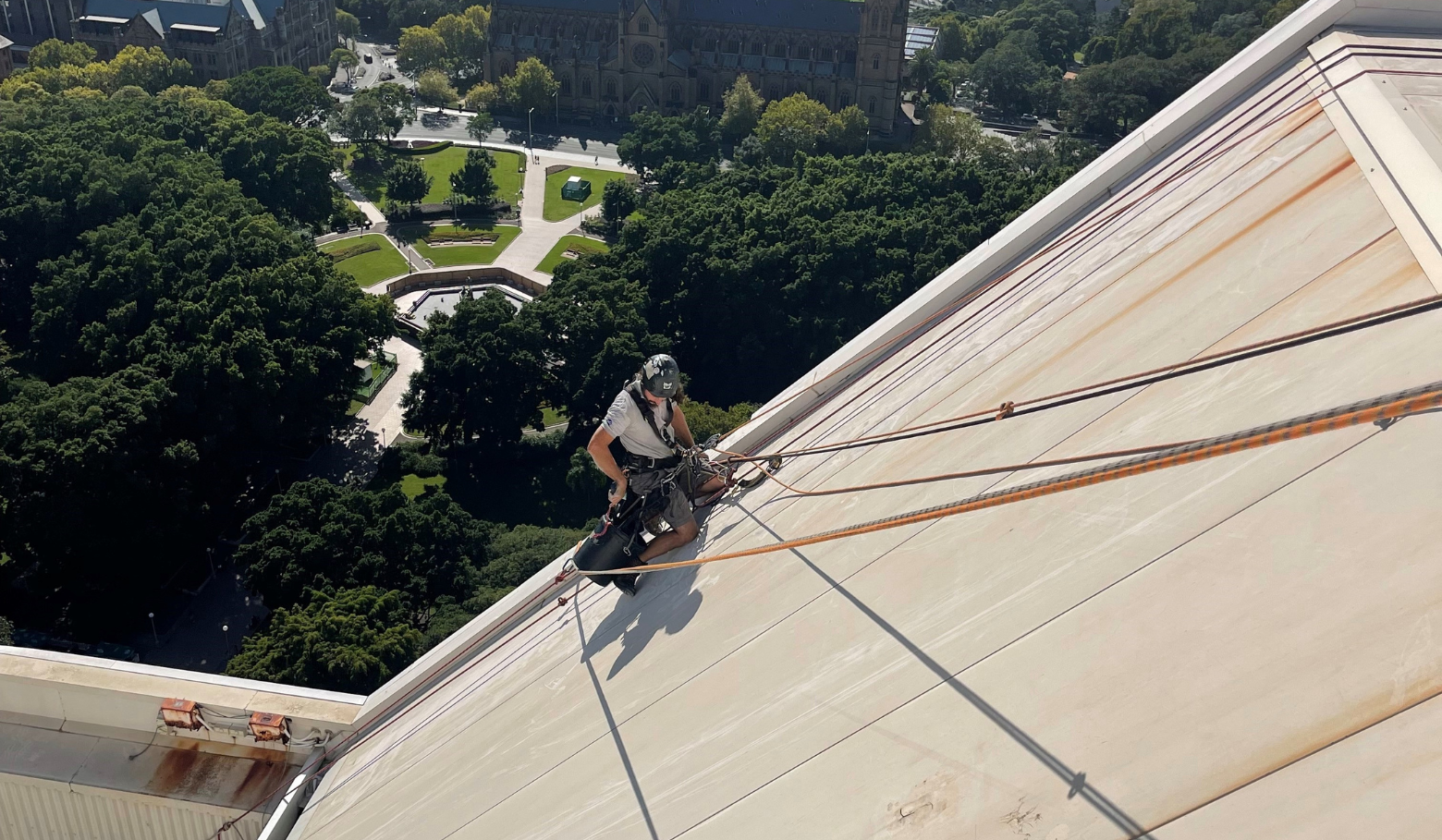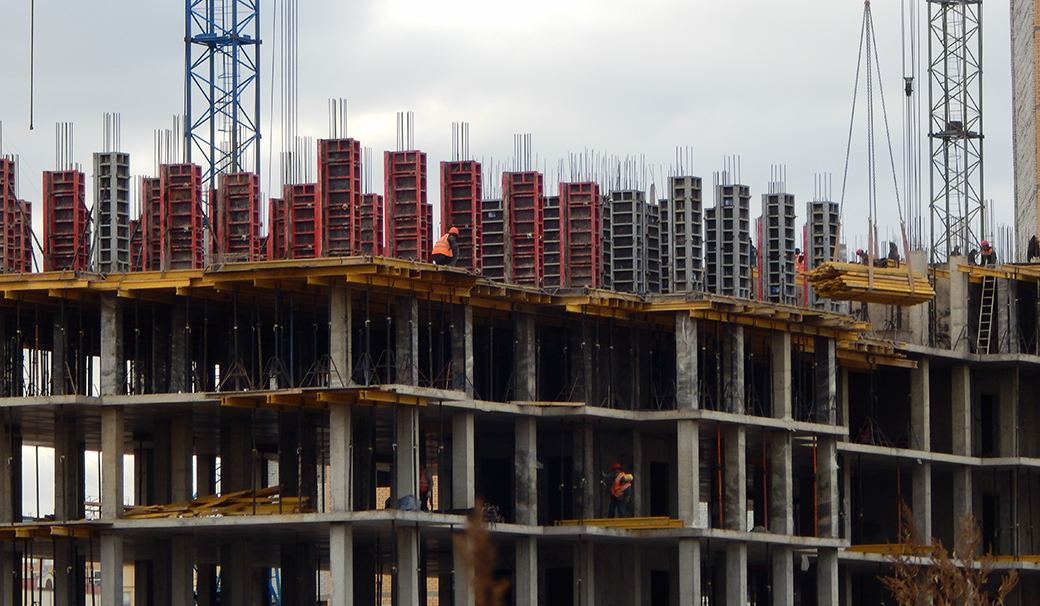Glass Blog
Rope access is a method used to reach high or difficult-to-access areas via a rope and harness system. It is commonly used to conduct a variety of work including glazing, cleaning, installation, restoration, repair, waterproofing, and painting.
What are the Benefits of Rope Access?
Rope access is the access method of choice for many building owners, property managers, strata managers, and facility managers. This is because it presents many benefits over alternative methods of access. Some of these benefits include:
- Efficiency: Rope access equipment can be assembled and disassembled very quickly. This reduces time requirements, allowing for a more efficient service.
- Safety: Rope Access Technicians must undergo extensive training in order to conduct rope access work.
- Versatility: Rope access allows workers to access areas that would not be accessible using other methods. It does not restrict mobility and can be used in an abundance of areas ranging from confined spaces to large-scale high-rise buildings.
- Environmentally Friendly: As rope access does not require the transportation of large, heavy equipment through the supply chain and on-site, it releases much fewer emissions than alternative access methods.
- Minimises Disruption: Compared to alternative height access methods, such as scaffolding, rope access has minimal disruption on a building and the building’s occupants.
If you require any work for your high-rise building or other hard-to-access structure, get in touch with Magic Glass. Our certified Rope Access Division offers a variety of services for both commercial and residential clients. These services include:
- External window and facade cleaning
- Height safety installation
- Make safe services
- Facade inspection and reporting
- Facade remedial repair
- Safety and debris netting
- Bird proofing and pest control
- Rust removal
- Facade painting and waterproofing
- Signage installation and removal
And more!
Contact Magic Glass for more information.
Construction projects can generate a significant amount of debris, including materials such as wood, metal, concrete, and drywall. This debris can pose a safety hazard for workers and the general public, as well as a potential liability for the construction company.
Debris netting is a versatile solution for containing and managing construction debris, and it has a number of benefits.
Read on for Magic Glass’ guide to debris netting in the construction industry.
What is Debris Netting?
Debris netting is a type of netting made from durable, high-strength materials, such as polypropylene or polyethylene. It is typically used to contain and manage debris during construction, demolition, or renovation projects. Debris netting is available in a range of sizes and colours, and it can be custom-cut to fit the specific needs of a project.
Benefits of Debris Netting
There are several benefits to using debris netting on construction sites:
- Safety: Debris netting can help prevent accidents and injuries by containing debris and preventing it from falling or blowing onto workers or the general public.
- Liability reduction: Debris netting can help reduce the liability of construction companies by preventing debris from escaping the construction site and causing damage or injuries to nearby properties or individuals.
- Visual appeal: Debris netting is available in a range of colours, and it can be used to cover unsightly areas or construction equipment. This can improve the visual appeal of the site, particularly if it is located in a highly visible area.
- Cost-effective: Debris netting is a cost-effective solution for managing construction debris, as it requires minimal installation and maintenance. It is also reusable, which can further reduce costs.
- Damage prevention: Debris netting catches falling debris, preventing it from falling onto other parts of the building and causing damage.
Debris netting is a versatile and cost-effective solution for containing and managing construction debris. It can help improve safety, reduce liability, prevent damage, and improve the visual appeal of a construction site. It can, however, be challenging to install, especially at heights.
Fortunately, Magic Glass is here to help! Our dedicated Rope Access Division is highly experienced at installing, inspecting, and maintaining debris netting-regardless of the size or height of the building.
For more information, or to get a free quote, call Magic Glass today!
Glass is both a functional and decorative material that can be used in many ways to improve your home and increase its value.
From increased safety to aesthetics, here are Magic Glass' top 5 ways glass can be used to improve your home.
1. Safety
Installing safety glass is a great way of boosting your home’s security and preventing injury in the event of breakage.
Safety glass such as toughened and laminated glazing units are more susceptible to force and are therefore much more difficult to break. This means that the likelihood of someone breaking into your home or glass shattering from severe weather events is drastically reduced.
In addition, toughened and laminated glass are designed to either stay intact or shatter into smaller pieces (rather than sharp shards) in the rare event of breakage.
2. Energy Efficiency
Most of our homes’ temperature losses or gains occur through our glass windows or doors. Fortunately, there are ways in which we can minimise these effects and make our homes more energy efficient.
Installing glass panels that are either multi-glazed, laminated or have low-emissivity coatings will drastically reduce heat transfer through your windows. This will help keep your home cooler in the summer and warmer in the winter without blowing your energy bill through the roof.
For more information on these types of glass, read our How To Make Your Home More Energy Efficient Using Glass blog.
3. Openness
Another benefit of glass is that it can make your home appear more open. Having large windows, glass sliding doors and mirrors around your home can alter the look and feel of your property by making it seem more spacious and less closed-off.
4. Natural Light
Glass fills your home with natural light which not only helps save you money on electricity bills, but also boosts your mood and energises you.
Natural light boosts the look and feel of your home and adds value to your property.
Whether through windows, glass doors or skylights, there are an abundance of ways that you can increase natural light in and around your home.
5. Decoration
Last but not least, glass installs can be used to decorate your home.
Stained, frosted and etched glass can be used to add colour and edge to your home, as well as privacy.
In addition, glass splashbacks and frameless screens can be used for both decoration and functionality.
For more information on using glass to improve your home, contact Magic Glass today.
With our own fabrication facility and a team of experienced glaziers, we are able to custom-make glass specific to your space and your needs.
When it comes to preventing falls on worksites, there are a number of height safety options you can consider. One of these options is edge protection.
What is Edge Protection?
Edge protection is a type of height safety system that involves physical guardrails around the edges of rooftops and fragile at-height surfaces, including skylights and polycarbonate sheeting. These physical barriers can be permanent or temporary.
Edge Protection Requirements
Each edge protection system must satisfy a number of criteria to be considered safe and compliant. They must be provided at every open edge of a work platform and be strong enough to withstand the force of someone falling.
Edge protection systems must also be comprised of a handrail, mid-rail, and toe-board, or a handrail and brick guard.
The specific requirements of your edge protection system will differ depending on factors such as roof pitch, surface, and length. Below are some general components all edge protection systems must include.
- Top, mid and bottom rails or toe-boards with gaps not exceeding 450 mm. Where toe-boards are used in place of bottom rails they should be able to withstand the likely impact loads.
- Toe-boards or mesh infill to prevent tools, materials or debris falling from the roof, unless exclusion zones that prevent all personal access below the roof edge are in place.
- No gap between the roof edge, including the gutter, and a guardrail located outside the roof line exceeding 100 mm.
- A clear distance between the roof cladding and the bottom rail of no less than 150 mm and no greater than 275 mm.
- A guardrail height above the roof surface of no less than 900 mm (for roofs with a pitch over 10 degrees, the effective height should be measured from a point 300 mm inside the roof edge).
- Infill panels are used where the pitch of the roof exceeds 26 degrees.
If you own or manage a high-rise building, it’s your responsibility to ensure that it is safe for all residents, visitors, workers, and passer-byers. If your building is deemed unsafe and injury occurs, you can be held liable.
One of the best ways to avoid this is to familiarise yourself with common defects that can occur and how to best deal with them. Read our blog on common building defects for more information on how to identify them. Otherwise, read on to find out how to best deal with high-rise defects.
Handling Building Defects
Different buildings will encounter different defects. The process of dealing with these defects can be generalised, however. Here are some top tips:
Remember that ignorance is not always bliss.
As we’ve previously stressed, if you own or manage a building, any defects that occur are your responsibility. Because of this, you want to be aware of how to identify any potential issues and have a basic idea of how to remedy them.
Be safe, not sorry.
Thorough and regular building inspections by accredited professionals, such as Magic Glass, are a must! They will identify any potential issues before you notice them. Not only will this ensure safety in your building, but it will also save you money as repairing damage in its early stages is much less expensive than repairing it a few months in.
In NSW, for minor defects, you have two years to start the process of getting the builder or developer to fix the defect. For major defects, you have six years. If your building is outside the warranty period, you may have to fund rectification yourself.
Sharing is caring.
Make sure you report defects to people who need to know. This will include your owners corporation, but also your insurer(s) and Fair Trading (especially if the defect is major). You will also need to inform residents and other building occupants if necessary.
Keeping good records is also important. Records are needed in case there are disputes and to demonstrate to future buyers that the building is well-maintained and safe.
Handling building defects can be stressful. Fortunately, Magic Glass is here to help. We offer fast, thorough, and cost-effective facade inspection, repair, and replacement services. Our experienced Rope Access Division allows us to carry out these services discreetly for all buildings, regardless of height or size.
Contact us today for more information!
Whether you own a house or manage a commercial property, making sure its facade is sufficiently waterproofed is a must.
What is Waterproofing?
Waterproofing is the process of applying a physical barrier or waterproof membrane to the exterior of a building to prevent moisture penetration.
Why is Waterproofing Important?
Waterproofing helps prevent a number of structural and health issues associated with moisture ingress. These include:
- Steel corrosion
- Concrete cancer
- Fungal growths
- Mould and mildew
- Water logging.
How Do You Identify Waterproofing Issues?
There are a number of tell-tale signs that indicate waterproofing. These include:
- Blistering and/or peeling paint
- Bubbles in the paint that hold water
- Mould, mildew, and fungal growths
- Rust stains
- Cracked walls
- Dampness.
If your commercial or residential building needs waterproofing, get in touch with the Magic Glass team today. Our dedicated Rope Access Division can offer discrete, cost-effective, and efficient waterproofing services for all buildings, of all sizes.
Contact us today for a free quote.
Rope access is a relatively new form of access method that more and more businesses are beginning to employ. Because it’s so new and often perceived as ‘scary’, many people have questions surrounding rope access and its uses.
Fortunately, Magic Glass is here to answer some frequently asked questions about rope access.
What is Rope Access?
Rope access is a form of work positioning that allows workers to access difficult - to - reach areas without the need of scaffolding or aerial work platforms . It involves the use of ropes and harnesses to support the worker as they complete the required job.
Why Use Rope Access?
There are a multitude of reasons why rope access is becoming more commonly used. These include:
- Increased safety
- Increased versatility
- Less disruption to the building
- Increased efficiency
- More cost - effective
What are the Applications of Rope Access?
Rope access is most commonly used in the construction industry. It can be used for:
- Structural inspections of buildings
- Height safety insta llations
- High - rise window and facade cleaning
- Concrete repair
- Painting and waterproofing
- Glass repair and replacement
- Signage installation and removal
Can Anyone Become a Rope Access Technician?
In order to become a Rope Access Technician you must undergo mandatory IRATA training to become certified.
Magic Glass Rope Access Division
Our Rope Access Division can offer a number of services such as:
- External window and facade cleaning
- Height safety installation
- Make safe services
- Facade inspection and reporting
- Facade remedial repair
- Safety and debris netting
- Bird proofing and pest control
- Rust removal
- Facade painting and waterproofing
- Signage installation and removal
And more!
To get a free quote on your rope access job, contact Magic Glass today.
Concrete spalling can occur on a wide variety of structures including concrete buildings, car parks, bridges, jetties, and tanks. It can have disastrous effects on the structural integrity and asset value of buildings and can pose serious threats to the health and well-being of occupants.
Having a basic understanding of what concrete spalling is and how it is treated will help you identify and remedy any spalling that may occur in or around your building.
What is Concrete Spalling?
Concrete spalling is the deterioration of steel reinforced concrete. It can be caused by a number of things including excessive exposure to moisture, oxygen and salts, freeze thaw cycling, and exposure to fire. The most common cause of spalling, however, is corrosion of the steel reinforcement bars.
Factors such as age, maintenance, concrete quality, depth of concrete coverage, and local environmental conditions have significant effects on the likelihood of concrete spalling occurring. For example, older buildings, buildings located by the sea, and buildings that are not maintained sufficiently are much more susceptible to concrete spalling.
What are the Effects of Concrete Spalling?
Concrete spalling can have a number of detrimental effects on the aesthetics, structural integrity, and safety of your building. It is an eyesore and can make your building appear poorly maintained and insufficiently cared for. This can deter potential buyers and renters for residential buildings and can impact business reputations for commercial buildings.
Spalling can also be harmful for workers, building occupants, and passer - byers. Mild concrete spalling can lead to falling debris and tripping hazards, whilst more severe cases can cause structural instability which can be even more dangerous.
From a commercial perspective, concrete spalling can also greatly reduce the asset value of your building. Maintenance costs increase as spalling becomes more widespread, so the longer you leave concrete spalling untreated, the more expensive remediation will be and the more your building will diminish in value.
How Do You Identify Concrete Spalling?
The tell-tale sign of concrete spalling is the flaking and chipping of concrete surfaces. If you notice large chunks of concrete missing or falling off any of your building’s surfaces, it can be safe to assume your building is experiencing spalling.
How Can You Prevent Concrete Spalling?
There are some measures that can be taken to prevent the occurrence of concrete spalling. These include:
- Proper management of concrete during pouring to ensure adequate coverage and sufficient concrete curing techniques
- Prevention of excess water in the concrete mixture
- Use of an effective anti-carbonation and chloride ion resistant coating system
- Application of water sealant to concrete surfaces to prevent water from getting into the concrete.
How Can Concrete Spalling Be Repaired?
If your building has succumbed to concrete spalling, there are a number of ways you can go about repair and restoration. For mild spalling, you may be able to repair the concrete with patching and coating, for more severe cases, however, you may need to have your concrete resurfaced or completely replaced.
If you do notice any signs of concrete spalling, you should get in contact with a professional.
At Magic Glass, we offer building remediation services at-heights and in hard-to-access areas. Our experienced Technicians will be able to inspect and repair your concrete spalling issues regardless of where they are occurring.
Get in contact with our team for more information.
If you’re a property owner or strata manager, it is your responsibility to ensure your building is kept in good condition. This not only ensures that your building is looking good, but also ensures that it is safe for its occupants and the general public, alike.
An important step in doing this is getting regular facade inspections.
Regular facade inspections are critical in maintaining the safety and visual appeal of buildings. They can identify potential issues before they become major structural complications, in turn, saving you money and drastically reducing the risk of injury and mortality. Regular inspections can also improve the aesthetics and value of your property.
Facade inspections regularly pick up issues that cannot be seen from the ground and could be potentially dangerous if not fixed, such as cracked render and concrete.
It is generally recommended that building owners and managers get their property’s facade inspected every 5 years if their building is in excellent condition. If it is in fair condition, it should be inspected every 2-3 years, and if it is in poor condition, it should be inspected yearly.
If you notice any physical signs of deterioration, such as cracks, rust stains, deterioration around balconies, and displacement of stone, concrete blocks or bricks, you should get your building inspected immediately.
For facade inspections of both commercial and residential buildings, contact the Magic Glass team. Our experienced Rope Access Technicians can conduct thorough and efficient external property inspections for high-rise buildings of all sizes.
Call us today for a free quote.
Safety glass is a type of glass that is designed to be less likely to break and less likely to inflict serious injury in the rare event it does break. The two main types of safety glass include toughened (or tempered) glass and laminated glass.
One of the most common questions we get asked is ‘which type of glass is the safest?’ Although toughened glass is most commonly recommended for safety, it does ultimately come down to what it is being used for.
Toughened Glass
Toughened glass is manufactured through the use of thermally or chemically controlled treatment processes. It is these processes that strengthen the glass and make it more resistant to force.
Although it is very difficult to break toughened glass, it’s not impossible. In the rare event breakage does occur, toughened glass shatters into many smaller pieces rather than large, sharp shards of glass. Because of this property, it is much safer than standard, annealed glass and is significantly less likely to inflict injury. This is why toughened glass is often used in motor vehicle windows and diving masks.
Toughened glass is also Grade A safety glass and is therefore frequently used in areas and spaces where compliance with Australian Glass Safety Standards is a must. This includes schools, hospitals, low-level glazing, aged care facilities, and child care centres.
Laminated Glass
Laminated glass is composed of two pieces of glass with an interlayer commonly made from polyvinyl butyral. This prevents the glass pieces from shattering as they remain stuck to the interlayer rather than breaking off into sharp shards.
As laminated glass sticks together even when it is shattered, it provides much greater security against potential break-ins, severe weather, and sudden impact. Because of this, laminated glass is most commonly used in shopfronts, windows and doors, balustrades, and glass fencing.
If you’re wanting to install safety glass into your commercial or residential building and are still unsure which type is best for you, give Magic Glass a call! Our friendly team will be able to provide you with recommendations and point you in the right direction when it comes to installation.
We can also provide you with a free quote for custom safety glass fabrication and installation.
When it comes to working at heights, implementing effective safety procedures is a must. Falls from heights are the second leading cause of work-related mortalities within Australia, so ensuring your building or worksite is secure and has preventative measures in place is critical.
The most common types of height safety systems are fall arrest and fall restraint systems. Although they are commonly used interchangeably, they have a number of key differences. Read on to find out more.
Fall Arrest Systems
Fall arrest systems are designed to protect workers in the event of a fall. When a worker falls, the arrest system will catch them, preventing the occurrence of injuries or deaths.
Fall arrest systems fall into two categories - personal and general. Personal fall arrest systems involve specific Height Safety PPE and attachment systems, such as harnesses and ropes. General fall arrest systems protect all workers as a whole rather than individually, such as safety nets and catch platforms. Both types of fall arrest systems should prevent workers from falling no more than two metres.
Examples of fall arrest systems include:
- Full-body harnesses
- Suspension belts
- Rope lanyards
- Safety nets
- Catch platforms
Fall Restraint Systems
Fall restraint systems are preventative safety measures. They are designed to prevent falls altogether, rather than catching workers after they have fallen.
Examples of fall restraint systems include:
- Guardrails
- Walkway systems
- Static restraint lines
These restraint systems are used for lower-risk situations, where falling is less likely or less hazardous.
Having effective fall protection systems in place is an absolute necessity in preventing workplace injuries and deaths.
If you’re unsure about your requirements or what fall protection equipment you should be using for your building or worksite, get in contact with Magic Glass for more information.
Whether your building is high-rise, low-rise, commercial or residential, chances are that it has faced some kind of building defect. More often than not, these defects are minor, however it is still important that they are remedied in order to prevent further damage and the occurrence of injury.
Read on for 5 common building defects that all property owners should be aware of.
1. Poor Roofing Materials
Poor roofing materials can lead to leaks, rusting, and erosion. Not only are these things detrimental to the visual appeal of your building, but they can also cause severe structural damage if left unresolved.
2. Drainage Issues
Problems with drainage often come up due to boycotted water outlets. When a gutter is blocked, it can affect the entire structure of a building and lead to future failures if not quickly addressed. Even bad rainwater drainage systems can result in leaks that can potentially ruin the walls and reduce the quality of the building structure.
Another common issue is blocked weep holes preventing water from being able to escape from a facade and causing leaks internally.
3. Structural Complications
These are the defects that you can find on the foundations of the house, such as wall cracks and misplaced wall posts. Structural complications should be addressed immediately as they can be a serious hazard to the health and livelihood of your building’s inhabitants.
4. Waterproofing Problems
These are defects related to poor drainage, leaking roofs, and any other problems related to poor waterproofing. As waterproofing problems can lead to structural complications, they need to be remedied as soon as possible.
5. Facade Defects
Facade defects occur on the exterior of a building. They include defects such as brick cracks and concrete spalling. Often these defects occur naturally through exposure to moisture or harsh weather conditions.
If you encounter any signs of these defects in or around your building, give Magic Glass a call. Our dedicated Rope Access Technicians can remedy all external building defects, regardless of the size and height of your building.



